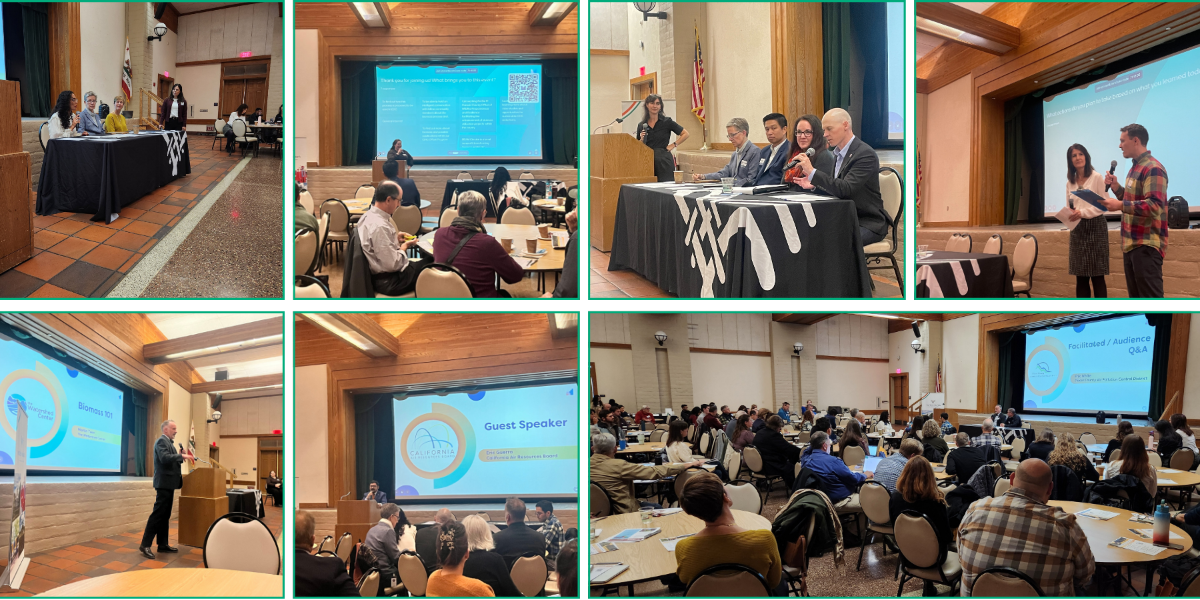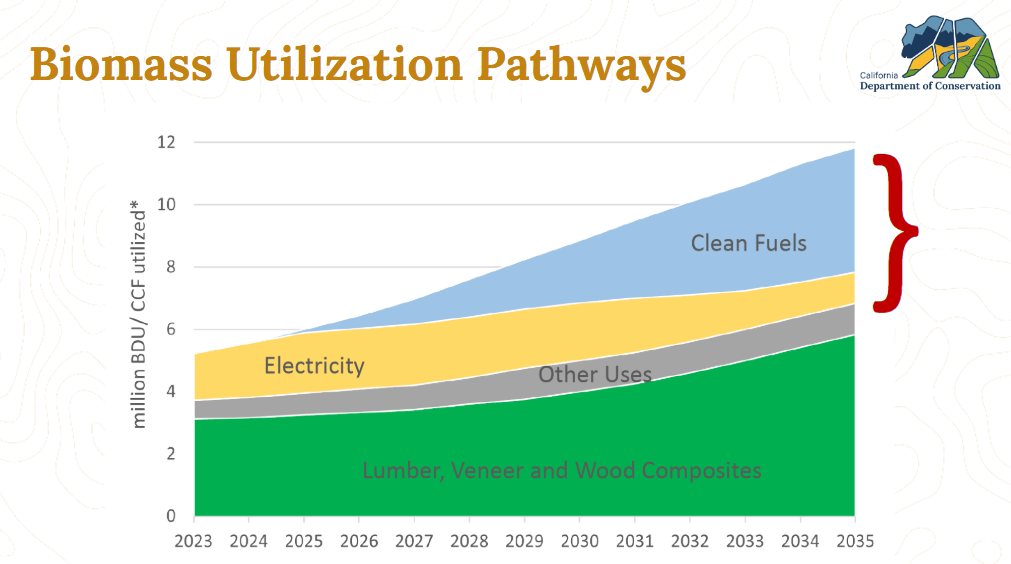The Benefits of a Biomass Circular Economy
On Wednesday, November 20th, 2024 at the Folsom Community Center, Valley Vision hosted a regional convening on the opportunities around biomass utilization and the solutions necessary for the Greater Sacramento region to address air quality, forest health, and workforce development. Regional leaders representing local and state governments, public agencies, non-governmental organizations, community groups, educational institutions, and industry gathered together to gain a shared understanding about biomass utilization; discuss challenges and opportunities; and propel solutions for our forests, working lands and communities.

The Bioeconomy and Establishing a Shared Understanding
Before we discuss solutions, we need to land at a shared understanding of biomass and its uses. Biomass comes from three main sources: municipal waste, agriculture and forest residues. It plays an essential role in the circular economy in that it can be utilized as a renewable source of energy and other marketable products such as building materials, and mulch in landscape and agricultural applications. Currently, we have an abundance of biomass or bioresources in our region, and we do not have a feasible, consolidated strategy to manage these potential resources. As a result, woody biomass fuels catastrophic wildfires, agricultural residues burn in large open piles, and municipal waste overflows in our landfills. These results are problematic because they endanger our people and drain from our economy. There has to be an alternative to our region’s issues.
Obstacles and misinformation surrounding biomass utilization persist. Traditional biomass utilization is combustion of organic material such as open pile burning, emitting toxics and pollutants in the air. However, as technology improves, there are innovative ideas for biomass utilization that address our resource challenges, mitigate pollution impacts, and serve community needs. Now is the time to catalyze these innovative ideas, which emit less toxics and pollutants than wildfires and large-scale pile burning, and does more good than harm for communities.
“There is a perception that these facilities are not controlled to the maximum extent they can – this is incorrect. Biomass facilities are not massive, smoke-stack buildings. We have technologies for small-scale, community biomass processing facilities”. – (Martin Twer, Biomass Program Director, The Watershed Center)
Challenges and Opportunities for Biomass Utilization in our Region
Today’s innovative idea of biomass utilization is a multi-benefit approach. We’re not talking about large-scale clear-cutting in our region. We’re talking about innovative biomass utilization that propels efficient forest management, agriculture and food system resilience, and diverse community-scale solutions. Biomass utilization is not the “perfect” solution, but it exists as a viable alternative and sustainable solution to our collective issues. Valley Vision convened regional leaders representing state and local governments, environmental and educational organizations, and industry, who shared challenges and constraints in addition to areas of opportunity to advance biomass utilization in our region.
Below are key takeaways on the challenges and opportunities for biomass utilization in our region:
Case Studies and Policy Considerations
Barriers and Challenges:
Insufficient investments in validating and scaling up the use of technology, combined with the rapid pace of research and development compared to commercial and pilot-scale manufacturing, pose significant barriers to biomass utilization. Limited investments in the bioeconomy market and supply-chain infrastructure restrict access to the capital needed for market expansion. Furthermore, regulatory complexities and permitting delays, such as challenges related to CEQA, short-term contracts for pilot projects, and the closure or risk of closure of biomass facilities, further hinder the ability to scale up biomass utilization effectively.
Strategies and Opportunities:
To enhance biomass utilization, attracting more investments by involving local, state, and private entities while broadening and expanding partnerships is essential. These efforts can support entrepreneurs and innovations, build trust with communities and businesses, and create workforce development and training opportunities. Diverse partnerships should include local government leadership actively collaborating with tribal leadership and industry partners. Prioritizing the circular bioeconomy sector at regional and state levels requires key actions such as offering tax incentives and credits for bioeconomy projects, investing in supply-chain infrastructure, and establishing longer-term contracts for facilities and operations. Additionally, creating an aggregation hub or public entity to act as a “broker” for long-term biomass feedstock contracts and streamlining CEQA processes, particularly for old sawmill sites, can facilitate progress. Aligning circular bioeconomy projects with California’s carbon reduction programs and goals will further drive growth in the bioeconomy sector.

Source: California Department of Conservation. “Draft Wood Utilization Strategy”: Biomass Utilization Pathways expected in the next 10 – 20 years.
Workforce Development: Gaps and Skills Needs
A volatile and risky industry prevents job growth and market expansion. “The bioeconomy market or industry is a relatively new market. Those who are interested in investing in the market want more assurances. Currently, it’s volatile and risky”. (Kerri Timmer, Forest Health Coordinator, Placer County).
The bioeconomy industry, along with adjacent sectors like forestry, agriculture, transportation, and manufacturing, faces workforce challenges due to limited development and training opportunities. Short-term contracts for biomass facilities deter logging and hauling companies from collaborating or entering agreements. Additionally, the seasonal and high-risk nature of forestry jobs exacerbates workforce issues, including difficulties with recruitment, retention, and opportunities for upskilling or professional development. However, the arrival of new companies in the region, such as Glanris, Rio Bravo, and initiatives supported by the governor, presents an opportunity to revitalize biomass utilization and address these workforce challenges through increased investment and job creation.
Opportunities for Workforce Development
The establishment of a hub or public entity to manage risks and negotiate longer-term contracts would not only drive industry growth but also create new job opportunities throughout the supply chain. By stabilizing operations and encouraging investment, such an approach could support sustainable growth in biomass utilization. Additionally, identifying and developing more workforce training programs tailored to the bioeconomy sector can further align industry development with the State’s carbon reduction goals, fostering a skilled workforce prepared to meet the demands of a growing circular bioeconomy.
Final Thoughts
Valley Vision closed the program by summarizing key event learnings and highlighting key points from audience discussion and feedback at the convening. Suggestions include promoting public-private partnerships that uplift and implement community-based solutions, prioritizing local and state advocacy for biomass utilization, and strategizing for advocacy efforts at the federal level.
To learn more about our region’s long-term initiative for inclusive economic development and access to high-quality jobs, visit We Prosper Together. The working lands sector (agriculture, forestry, mining and related manufacturing industries) is identified as one of our region’s target sector strategies with the greatest opportunity for job growth.


